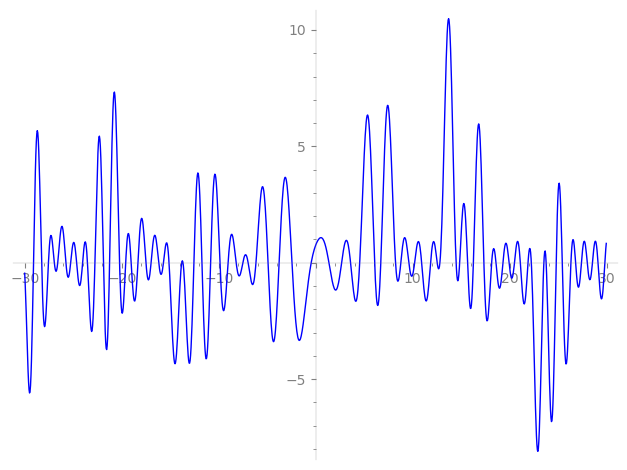| L(s) = 1 | + (−0.866 + 1.5i)2-s + (0.366 − 0.633i)3-s + (−0.5 − 0.866i)4-s − 5-s + (0.633 + 1.09i)6-s + (−1 − 1.73i)7-s − 1.73·8-s + (1.23 + 2.13i)9-s + (0.866 − 1.5i)10-s + (0.633 − 1.09i)11-s − 0.732·12-s + 3.46·14-s + (−0.366 + 0.633i)15-s + (2.49 − 4.33i)16-s + (−1.73 − 3i)17-s − 4.26·18-s + ⋯ |
| L(s) = 1 | + (−0.612 + 1.06i)2-s + (0.211 − 0.366i)3-s + (−0.250 − 0.433i)4-s − 0.447·5-s + (0.258 + 0.448i)6-s + (−0.377 − 0.654i)7-s − 0.612·8-s + (0.410 + 0.711i)9-s + (0.273 − 0.474i)10-s + (0.191 − 0.331i)11-s − 0.211·12-s + 0.925·14-s + (−0.0945 + 0.163i)15-s + (0.624 − 1.08i)16-s + (−0.420 − 0.727i)17-s − 1.00·18-s + ⋯ |
Λ(s)=(=(845s/2ΓC(s)L(s)(0.872+0.488i)Λ(2−s)
Λ(s)=(=(845s/2ΓC(s+1/2)L(s)(0.872+0.488i)Λ(1−s)
| Degree: |
2 |
| Conductor: |
845
= 5⋅132
|
| Sign: |
0.872+0.488i
|
| Analytic conductor: |
6.74735 |
| Root analytic conductor: |
2.59756 |
| Motivic weight: |
1 |
| Rational: |
no |
| Arithmetic: |
yes |
| Character: |
χ845(191,⋅)
|
| Primitive: |
yes
|
| Self-dual: |
no
|
| Analytic rank: |
0
|
| Selberg data: |
(2, 845, ( :1/2), 0.872+0.488i)
|
Particular Values
| L(1) |
≈ |
0.734187−0.191688i |
| L(21) |
≈ |
0.734187−0.191688i |
| L(23) |
|
not available |
| L(1) |
|
not available |
L(s)=p∏Fp(p−s)−1 | p | Fp(T) |
|---|
| bad | 5 | 1+T |
| 13 | 1 |
| good | 2 | 1+(0.866−1.5i)T+(−1−1.73i)T2 |
| 3 | 1+(−0.366+0.633i)T+(−1.5−2.59i)T2 |
| 7 | 1+(1+1.73i)T+(−3.5+6.06i)T2 |
| 11 | 1+(−0.633+1.09i)T+(−5.5−9.52i)T2 |
| 17 | 1+(1.73+3i)T+(−8.5+14.7i)T2 |
| 19 | 1+(2.09+3.63i)T+(−9.5+16.4i)T2 |
| 23 | 1+(2.36−4.09i)T+(−11.5−19.9i)T2 |
| 29 | 1+(−4.73+8.19i)T+(−14.5−25.1i)T2 |
| 31 | 1+0.196T+31T2 |
| 37 | 1+(−2+3.46i)T+(−18.5−32.0i)T2 |
| 41 | 1+(−1.73+3i)T+(−20.5−35.5i)T2 |
| 43 | 1+(5.09+8.83i)T+(−21.5+37.2i)T2 |
| 47 | 1−6T+47T2 |
| 53 | 1+10.3T+53T2 |
| 59 | 1+(−7.56−13.0i)T+(−29.5+51.0i)T2 |
| 61 | 1+(6.19+10.7i)T+(−30.5+52.8i)T2 |
| 67 | 1+(−7.19+12.4i)T+(−33.5−58.0i)T2 |
| 71 | 1+(0.633+1.09i)T+(−35.5+61.4i)T2 |
| 73 | 1+4T+73T2 |
| 79 | 1−12.3T+79T2 |
| 83 | 1+6T+83T2 |
| 89 | 1+(0.464−0.803i)T+(−44.5−77.0i)T2 |
| 97 | 1+(1+1.73i)T+(−48.5+84.0i)T2 |
| show more | |
| show less | |
L(s)=p∏ j=1∏2(1−αj,pp−s)−1
Imaginary part of the first few zeros on the critical line
−9.875358010303033231039058012860, −9.033515436622713916300401188990, −8.201941169708284026535211248508, −7.51150989214283409769236694373, −6.96757060794251923391644345966, −6.15902672120335565290123727514, −4.91571308532941091287621851719, −3.77366062779197788746922214685, −2.45042520467653097179628716097, −0.46682104130573464460839923121,
1.36080685438362556784152299015, 2.67025620815395685920156934666, 3.59205887717867675853813012968, 4.53205595259159254271444638058, 6.06942734033980682650467207497, 6.70715516898120437988242743981, 8.227640731943373282543952092959, 8.772347981143346306713088820353, 9.599539037961078440896242090537, 10.19520777975385103019731767614

